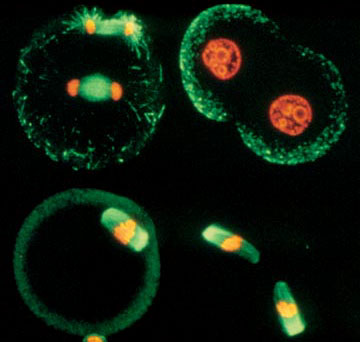Scientists from Johns Hopkins University in the USA, who developed an elaborate system for testing the mechanism of cell division, discovered that common sugars function as part of the switches responsible for this division

In their article, published in the scientific journal Science Signaling, the researchers reported that they focused on developing a system that could allow a human cell to divide into two, one that would mimic the complex natural biochemical system involving hundreds of proteins. The popular opinion regarding the task of turning these proteins off and on - that is, determining the exact time for cell division - was placed on the shoulders of substances called phosphates - chemical compounds that contain the element phosphorus, and which are attached to proteins and removed from them in a process called phosphorylation.
Contrary to this, the scientists claim in their new study, there is another layer of control through a sugar-based protein modification process called O-GlcNAcylation (ON-acetylglucosamine, the Wikipedia entry). "It seems that this sugar-based system has a great impact, and is common in signaling pathways for cell division like its corresponding phosphorylation system, and even has a role in controlling the phosphorylation process itself," explains the lead researcher. Since the sugar powder has a number of innovative properties - it is small, easy to change and has no electrical charge - it is almost invisible to researchers who use normal physical measurement methods to identify substances, such as mass spectrometry.
Suspecting that the sugar known as O-GlcNAc may take part in the cell division phase, the researchers designed a diagram to map the proteins using mass spectroscopy methods. Basically, they applied a combination of chemical modification methods and enrichment methods, and innovative technology to fragment the proteins participating in the mechanism responsible for cell division in order to expose them and determine their molecular composition. With the help of this system, the researchers were able to identify more than one hundred and fifty sites in these proteins, to which the O-GlcNAc sugar binds. In addition, the researchers discovered that more than three hundred sites in these proteins contain the already known phosphorylation compounds. The researchers noticed that when the sugar fragment was found near or inside the site corresponding to the phosphorylation group, it actually prevented it from binding to the site. The proteins involved in the cell division mechanism did not undergo phosphorylation and activation before the sugar group was detached from them.
"You can imagine the phosphorylation as a kind of microswitch that regulates the cycle of cell division, and the sugar-based mechanism as a kind of safety switch that regulates the operation of the microswitches," explains one of the researchers.
Using human cell culture, the scientists discovered irregularities when they disrupted the process of cell division by adding the sugar. Despite the fact that the cell nucleus, which contains the chromosomes, divided correctly, the cells themselves did not divide and gave rise to a state of a large number of nuclei in each cell - a state known as polyploidy (having a number of chromosomes 3 times or more than normal) that also exists in many cancer cells.
The researchers not only mapped the binding sites for phosphorylation and sugar, but also measured the changes that occurred in the cell division mechanism, since the chemical changes function more as dimmer switches than as simple independent switches of two possible states: off/on. The researchers claim that this significant relationship between the phosphorylation process and the sugar-based process constitutes a change in the direction of the dominant paradigm today in the field of intercellular signaling. Intercellular signaling refers to the ability of cells to sense their changing environment and adjust their activity in response to an external signal. The new sugar switches imply that the cellular mechanism is much more complex than previously known. The news about the study

4 תגובות
I knew there was a health reason why I drink 5 teaspoons of sugar in my coffee..
Itzik:
It is never too late (said Rabbi Akiva).
After every article like this, I regret more that I didn't go to study chemistry
Super interesting article.
I have a criticism regarding the actual editing of the text.
It seems that the text was copied and pasted from somewhere else and was not adjusted. It says "Wikipedia entry", but this is not a link. It says "the news about the research" at the end, but this is not a link either.